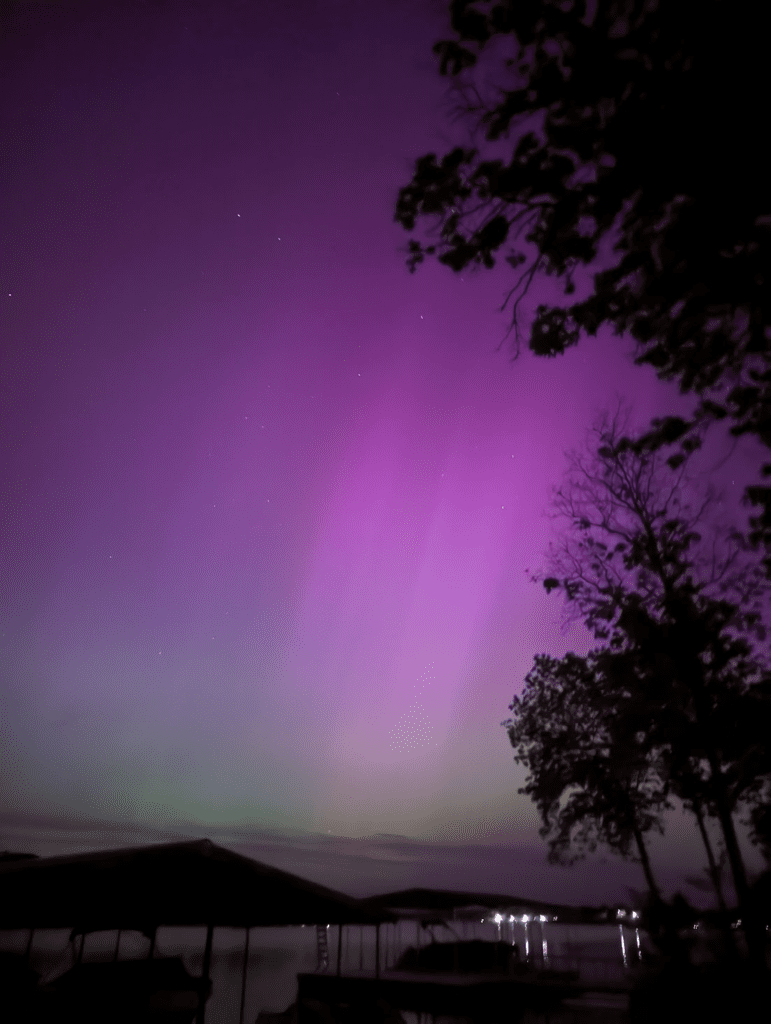It has been weeks of clouds, rain (which we needed), high winds (not needed), and schedule complications, so there has not been much observing from my urban observatory (yard) in Lenexa, Kansas. BUT, Friday and Saturday evenings I was finally able to do some astronomy, and observed both nights. Sunday I got a txt from a friend asking if I had seen the aurora borealis Saturday night. Huh? I’ve tuned out the news to a considerable extent and wasn’t aware that was a happening thing.
The image above is from my yard Saturday night. I was exploring with the Kowa Highlander 82 Fluorite and experimenting with an Astro-Tech AT80ED refractor as a support telescope (neatly inverting the misguided notion that binoculars support telescopes instead of vice versa). 😉
I noticed some hazy clouds but nothing in the Northern Lights category. I’m wondering how many locals confused filmy clouds for Northern Lights? 😏 Note: the aurora borealis is a naked eye phenomena — not something observed with binoculars or telescopes.
The name auroa borealis was coined by Galileo in 1619 combining the Roman goddess of the dawn, Aurora, with the Greek name of the north wind, Boreas. The lights are caused by solar particles from the sun interacting with the magnetic field in Earth’s upper atmosphere causing molecules (mostly oxygen and nitrogen) to fluoresce in colors of red (or pink) and green.
I have seen the Aurora Borealis from Kansas City in the past. It’s somewhat rare to see this far south, and in urban skies particularly. The few times I have seen it the colors have been pale pink or green and the light formations have a somewhat linear or patterned structure different from the misshapen veils of hazy clouds.
A friend and work colleague, Doug Turner, shared this fine image he took Saturday night (the same night I saw hazy clouds from my urban yard) with his mobile phone in night mode at Lake Viking in northwest Missouri near Altamont. Doug noted that the light display and color is more vivid in the image than what could be seen naked eye. If you live in an area where aurora displays are less visible, getting away from city lights (and being handy with your mobile phone camera 😉) is a good strategy for enjoying the light show.

More about support telescopes soon…


I went out Friday night at 11pm just on the off chance of seeing something, it was the first time ever id had alerts from AuroraWatchUK for northern lights and clear sky forecast at the same time. Usually only the Shetland islands and Scotland catch a glimpse but the whole UK was being treated to a show this night. I saw some grey whisps overhead but it was not until i pulled my phone out i realised what it was – what looked like a multi coloured aurora portal opening overhead as opposed to the typical “aurora curtains”. We got all the colours for a good hour.
Thank you for reporting your experience, Wrighty. It’s so much fun to have people from around the world sharing astronomical observations and experiences. 😊
Hi, Fiske. I learned about the Aurora possibly being visible here in Oregon Friday afternoon. Also, the head of NOAA’s Space Weather division mentioned at a news conference to use our smart phone cameras, and that proved golden advice.
I was outside at 11pm, texting my nephew, who was also outside at his family’s house about forty minutes south of me, in Bortle 4 territory.
“Nothing so far,” I texted. He replied with the same.
Then it was like flipping a switch. I noticed the sky had a faint white, undulating glow to it. I took a photo with my iPhone 15 Pro (newly arrived the day before) and the resulting image was alive with red and green color.
I woke my wife up. She’d given me permission to do so if the northern lights did show. She dressed and joined me outside. However, she had real difficulty noticing anything with her eyes. I had the advantage of years spent looking for faint objects in the sky, and also in knowing the night sky here well now, and it was obvious to me, if subtle.
The iPhone became my go-to instrument, revealing auroral effects like the curtain, beams, even a kind of burst. The most vivid colors were to the north, but even to the south images showed the aurora. Truly stunning. Mind you, I was practically hopping from foot to foot even seeing the subtle, faint whitish curtain moving through the sky to my naked eye.
My nephew and my brother-in-law, on the other hand, in Bortle 4, said the aurora was red-green to their naked eyes.
The next night, I decided to head to the local dark sky site in the Coast range, about 35 minutes from home. I hadn’t been there at night before, but Clearoutside rated it Bortle 3. Turned out half of Portland decided to be there, and I arrived just before the park was closed to further visitors, and set up in an overflow parking lot below the hilltop area. It was like being at one of our zoo concerts, lots of traffic and crowds.
The aurora was a no show, but I did bring budget 15x70s and 8x42s, and had fun viewing no less than five galaxies as well as admiring how bright M3, M5 and M13 were in the 15x70s. Definitely a dark sky site and one I need visit more often.
Thank you for this wonderful and detailed report, Dale! 😊 I wonder if you will have permission from your spouse to wake her for the next aurora “outburst”? 😁 I am telling myself that depending on the timing, it would be worthwhile to visit a darker location with my mobile phone to “view” the aurora from Kansas.